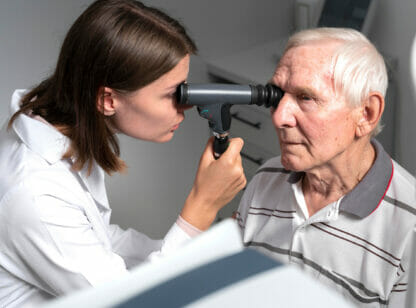
Dr. Amir Lavaf of Desert Regional’s Comprehensive Cancer Center
September is National Prostate Cancer Awareness Month. The campaign was established in 1999 by the American Foundation for Urological Disease to educate about risk factors and symptoms of prostate related diseases, to provide easily accessible prostate health, and to advocate for further research on prostate health issues.
Over the past two decades, we have seen much progress and change, but also uncertainty. Doctors and professional organizations began encouraging yearly PSA screening for men 50-70 and while the number of cases detected early significantly increased, so did the concerns of over-diagnosis and over-treatment. Were all early stage tumors harmful and in need of treatment? Was the option of watchful waiting worth the stress and uncertainty for patients? Were the costs and often-debilitating side effects worth the treatment?
Research continues in an attempt to establish definite answers to these questions, but leading organizations are often in disagreement on recommended protocol. However, all seem to agree that any man who is considering getting tested should first be thoroughly informed about the potential benefits – and the potential risks.
There is a significant amount of information available and people need to advocate for themselves, says Amir Lavaf, M.D., a radiation oncologist with Desert Regional Medical Center’s Comprehensive Cancer Center. “Educate yourself, get a second opinion, and don’t go on one physician’s recommendation.” He notes the benefit of a multi-disciplinary center where you will receive multiple points of view on your individual case from different practitioners: oncologists, surgeons, and radiologists. “Get as much information as possible to make an educated decision for yourself.”
Dr. Lavaf, who has trained in the management of prostate cancer at multiple institutions including New York Methodist Hospital, MD Anderson Cancer Center and Memorial Sloan-Kettering Cancer Center in New York, emphasizes that there is no ‘one size fits all’ approach to this disease. “Many factors are considered including family history, age, overall health and even ethnicity.”
When deciding if prostate cancer screening is for you, there are many pros and cons to consider: PSA screening may help detect prostate cancer early, but some prostate cancers are slow growing and never spread beyond the prostate gland; cancer is easier to treat and more likely to be cured if diagnosed in the early stages, but not all prostate cancers need treatment and there are potential side effects to consider such as incontinence and erectile or bowel dysfunction; PSA testing can be done with a simple blood test, but false positives are common and PSA counts can be elevated for reasons other than cancer.1
For some men, knowing is better than not knowing and for others, a diagnosis of prostate cancer can provoke anxiety and confusion.
Dr. Lavaf is a proponent of screening based on forty years of research by the American Cancer Society that shows an increase in survival rates due to screenings. “Whenever we find prostate cancer earlier, we are at an almost 99% 5-year survival rate across the board except for stage 4 cancer. We got there because of early detection.”
“When prostate cancer is detected and treated early, we have a high success rate,” he adds. “Once it gets to bones, which is one of the first places it likes to go, and it begins to cause symptoms and fractures, the treatment and everything involved can be devastating, so you want to catch it before it becomes systemic. When it’s local and we can manage it locally, that is when we can treat it most effectively.”
Most proponents of PSA screening will recommend starting at 55 except for men at higher risk, including African Americans who often present at an earlier age and in more aggressive forms, and those whose father or brother had prostate cancer; their screening is recommended at 40 or 45.2 The standard recommendation also indicates that patients over 70 should not be tested or treated, but those standards are based on average life expectancy and don’t apply to our local population says Dr. Lavaf.
“Here in Palm Springs, we are in a microcosm of super healthy seniors who at 85 may still be playing 18 holes of golf on a regular basis. This is not a guy who is going to pass away in the next couple of years and doesn’t need to have his prostate cancer treated.” Therefore, if an advanced-age patient presents with prostate cancer that could positively be treated with radiation, Dr. Lavaf offers and recommends it. “Again, it’s all based on that individual and his specific case and factors.”
According to Dr. Lavaf, diagnosis and treatment have both come a long way in the past decade. He and his team are contributing to the research and currently running Phase III clinical trials addressing standard of care for intermediate and high risk cases. The NRG Oncology project has brought together leading organizations in the industry to conduct oncologic clinical research and to broadly disseminate study results for informing clinical decision-making and health care policy. When patients are enrolled in the trial, their data and treatment plan is sent to MD Anderson which critiques and must approve the standard of care being recommended.
National Prostate Cancer Awareness Month has done more than simply evoke the conversation; it is helping to create both change and options that previously did not exist. When it comes to PSA testing, do your homework, speak with multiple professionals, and know your options in deciding what is right for you.
Dr. Amir Lavaf is a radiation oncologist with Desert Regional Medical Center’s Comprehensive Cancer Center in Palm Springs and can be reached at (760) 416.4800.
References: 1) MayoClinic.com, Diseases and Conditions: Prostate Cancer; 2) National Institutes of Health: National Cancer Institute. Prostate-Specific Antigen (PSA) Test.








































Comments (1)
“Dr. Lavaf is a proponent of screening that shows an increase in survival rates due to screenings.”
What Dr. Lavaf fails to point out is the effect of lead time and over diagnosis biases from screening on survival rates. i.e. over diagnosis greatly increases the number of harmless prostate cancers detected and this increase inflates the survival rate. Lead time bias greatly advances the time of detection (perhaps by 10 years or more) so even if the prostate cancer causes death anyway, the survival rate for a given number of years after earlier detection will be increased simply because detection is earlier.
Dr. Lavaf also fails to point out that no one has yet shown that PSA screening produces an improvement in overall survival when compared with usual care. This is the single most important fact that men should be advised of when considering PSA screening. Unfortunately, many doctors are not ethical enough to advise their patients of this fact which is a sad failing of the medical profession.